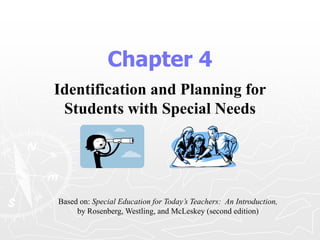
Chapter 4: Identification and Planning
- 1. Chapter 4 Identification and Planning for Students with Special Needs Based on: Special Education for Today’s Teachers: An Introduction, by Rosenberg, Westling, and McLeskey (second edition)
- 2. Chapter 4 Questions What is the process through which students’ eligibility for special education services is determined? How are infants and toddlers, preschoolers, and school-age children with special needs identified? What types of plans are made for students with special needs?
- 3. Rosenberg/Westling/McLeskey Special Education for Today’s Teachers: An Introduction Copyright © 2008 by Pearson Education, Inc. All Rights Reserved IDEA Part C: Ages 0-2
- 4. Rosenberg/Westling/McLeskey Special Education for Today’s Teachers: An Introduction Copyright © 2008 by Pearson Education, Inc. All Rights Reserved Programs for families with children, birth to 3, with disabilities and developmental delays. Provides services to families to help children reach their potential. State and federally funded through IDEA. In Texas, the lead agency is the: Early Childhood Intervention
- 5. Rosenberg/Westling/McLeskey Special Education for Today’s Teachers: An Introduction Copyright © 2008 by Pearson Education, Inc. All Rights Reserved Eligibility for ECI Services Developmental Delay Atypical Development Medical Diagnosis
- 6. Rosenberg/Westling/McLeskey Special Education for Today’s Teachers: An Introduction Copyright © 2008 by Pearson Education, Inc. All Rights Reserved Steps in the ECI Process Child Find Referral (2 day rule) Intake/Screening Evaluation IFSP meeting Service Delivery Review Transition
- 7. Rosenberg/Westling/McLeskey Special Education for Today’s Teachers: An Introduction Copyright © 2008 by Pearson Education, Inc. All Rights Reserved Array of ECI Services Assistive Technology Audiology Developmental Services Early Identification, Screening & Assessment Family Counseling Family Education Medical Services Nursing Services Nutrition Services Occupational Therapy Physical Therapy Psychological Services Service Coordination Social Work Services Speech-Language Therapy Vision Services
- 8. Rosenberg/Westling/McLeskey Special Education for Today’s Teachers: An Introduction Copyright © 2008 by Pearson Education, Inc. All Rights Reserved Location of ECI Services Services are provided in homes and community settings. Young children learn best when taught in natural and familiar environments.
- 9. Rosenberg/Westling/McLeskey Special Education for Today’s Teachers: An Introduction Copyright © 2008 by Pearson Education, Inc. All Rights Reserved IDEA Part B: Ages 3-21
- 10. Preschool (ages 3-5) Eligible children exhibit developmental delays in: communication gross and fine motor skills cognitive skills social or emotional behavior adaptive behavior (self-help) Children can be labeled “developmentally delayed” rather than with a specific disability category label. Use same identification process as that used for school-aged children. Services provided by public school system (PPCD class, speech therapy, etc.).
- 11. Rosenberg/Westling/McLeskey Special Education for Today’s Teachers: An Introduction Copyright © 2008 by Pearson Education, Inc. All Rights Reserved Effectiveness of Early Intervention Reduces or eliminates developmental delays Results in fewer children being retained in later grades Reduces educational costs to school programs Improves the quality of parent, child, and family relationships
- 12. Rosenberg/Westling/McLeskey Special Education for Today’s Teachers: An Introduction Copyright © 2008 by Pearson Education, Inc. All Rights Reserved Multi-Tier System of Supports or Response to Intervention http://www.rti4success.org/
- 13. Rosenberg/Westling/McLeskey Special Education for Today’s Teachers: An Introduction Copyright © 2008 by Pearson Education, Inc. All Rights Reserved Multi-Level “Tiered” Intervention Early Intervening Services in General Education Special Education &/or Additional Early Intervening Services 1 2 3 Progress Monitoring 3 Tiers 80% should be making acceptable progress.
- 14. Rosenberg/Westling/McLeskey Special Education for Today’s Teachers: An Introduction Copyright © 2008 by Pearson Education, Inc. All Rights Reserved Purpose of MTSS/RTI Limit academic failure by providing timely assistance Provide information about instructional needs Provide data for potential special education evaluation Eliminate inadequate instruction as possible cause of low achievement Reduce the number of referrals for special education Accurately identify children with true disabilities
- 15. Identification Process (after RTI)
- 16. Rosenberg/Westling/McLeskey Special Education for Today’s Teachers: An Introduction Copyright © 2008 by Pearson Education, Inc. All Rights Reserved Referral Can be submitted by anyone (teacher, parent, other school personnel, etc.) Describes concerns (observations) about academic and/or behavioral performance Identifies interventions attempted and results
- 17. Rosenberg/Westling/McLeskey Special Education for Today’s Teachers: An Introduction Copyright © 2008 by Pearson Education, Inc. All Rights Reserved Evaluation Individual evaluation in all areas related to suspected disability Can include RTI data Includes more than one test Use validated, unbiased tests Administered by qualified persons Given individually, in students’ native language Must have parents’ consent
- 18. Rosenberg/Westling/McLeskey Special Education for Today’s Teachers: An Introduction Copyright © 2008 by Pearson Education, Inc. All Rights Reserved ARD/IEP Meeting Participants: general education teacher, special education teacher, administrator, evaluator, specialists/therapists, parent, and possibly others (student, advocate, doctor, etc.) Review evaluation data Decide whether child has disability Identify needs of the child Determine placement and services
- 19. Individualized Education Program (IEP) Present level of performance Annual measureable goals How progress measured and reported Statement of special education and related services Extent of participation in general education Dates, frequency, location, and duration of services
- 20. Other Special Education Plans Individualized Family Service Plan (ISFP) 504 Plan Behavior Intervention Plan Transition Plan
